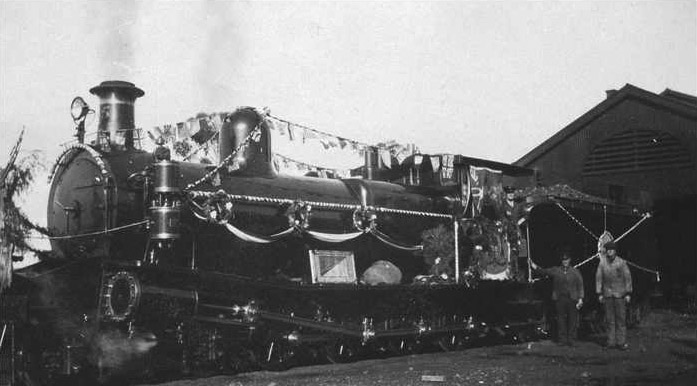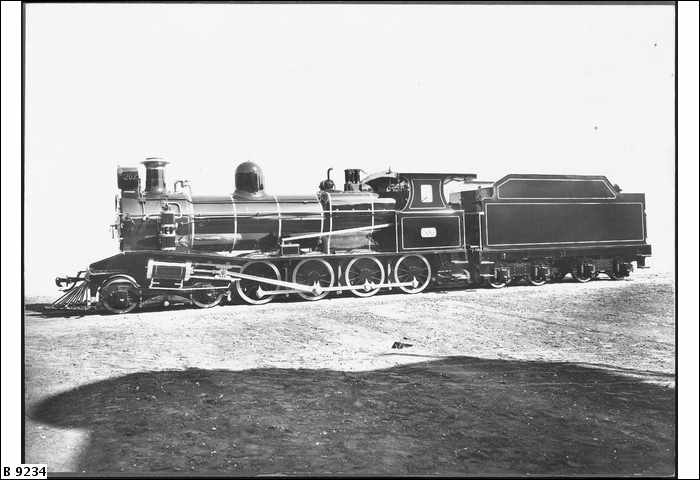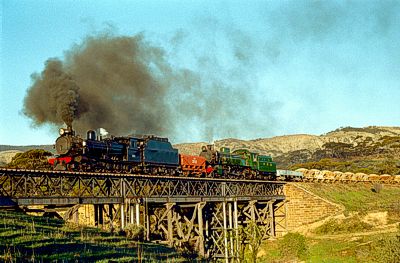The prototype engine, No. 180, was built at the Islington Workshops to the design of T.S. Roberts, and entered service on the Northern Railway (now Peterborough Division) in December 1903. Over the years seventy-eight T class locomotives were built for the SAR, nos. 23, 24, 44 to 48, 50, 51, 180 to 186, 197 to 258. Four were built at the Islington Workshops, thirty-four by James Martin and Co. at Gawler, including T186, and forty by Walkers at Maryborough, Queensland.
These simple, yet rugged and purposeful, locomotives were principally built to supersede the Y class hauling the heavy ore traffic between the mines of Broken Hill and the smelters at Port Pirie. The design of the T was traditionally British but there was nothing in England quite like it. Colonial independence asserted itself from the beginning, and over the years the engine's initial good looks were dramatically modified. Electric headlight and turbogenerator were fitted; adhesion blocks, re-railing jacks, compressor silencer and blowdown muffler decorated the running plate and boiler. The smokebox actually grew in two stages; the first lengthening occurred when the superheated boilers were fitted, and the second extension was the result of the 'Cyclone' spark arrestor equipment fitted inside the smokebox. In the meantime the tender grew in size, eventually dominating the cab as the sides extended upward to increase coal and water capacity. More recently the oil fired conversions, which included T186, had a large oil tank dropped over the coal space. When built they must have seemed sleek and dashing in comparison to the dainty Y class, and in modern times their inner charm shone through their work-a-day guise to strike a chord in those who beheld them. The T class soldiered on in profusion until the 1960s, when dieselisation, standardisation and age took their inevitable toll. It is from this latter period that many railway enthusiasts have their fondest memories of the T's exploits: shifting the wheat and produce of the day.
T class locomotives continued to operate to Quorn and Hawker until 1970 when the Quorn to Hawker line was closed.



Technical specifications
| Wheel arrangement | 4-8-0 | |
|---|---|---|
| Weight | 74 tons 14 cwt | 76.2 t |
| Length | 54 ft 0 in | 16.46 m |
| Tractive effort | 21,900 lb | 97.4 kN |
| Boiler pressure | 185 psi | 1280 kPa |
| Driving wheels | 3 ft 7 in | 1.09 m |
| Cylinders | 16½ x 22 in | 420 x 560 mm |
| Valve gear | Stephenson | |
| Grate area | 17.3 ft² | 1.6m² |
| Coal capacity | 8 tons | 8.1 t |
| Water capacity | 2,400 gal | 11 000 L |
Representatives in the Pichi Richi Railway collection
T186
Peterborough (then Petersburg) was the home base of T186 from its introduction to service on 9 December 1909 until condemned on 18 May 1970 after having run 2,068,430 km (1,284,739 miles). In earlier years T186 was frequently seen at the head of the Quorn Limited Mixed.
T186 was worked for the last time by the SAR on 16-17 May 1970 on an Australian Railway Historical Society tour train, when it was double-headed with T199 to Quorn and into the Pass as far as Summit. T186 was condemned next day and later purchased by Sims Metals for scrap. However there was a reprieve! Dean Harvey of the ARHS Tours Committee had obtained an option on a potential purchase, and when the Pichi Richi Railway was formed it was seen that there could be a new home for old T186. The option was quickly transferred to the PRR, together with a $500 donation from the ARHS, and new hope was kindled. A young lady donated another $1,000, and it eventually cost $2,000 to buy the remains from the scrap merchant.
At the time the South Australian Railways still had the expertise and capacity to attempt a restoration. PRR had the enthusiasm, so arrangements were made to obtain a quote from the Islington Railway Workshops. Preliminary indications suggested that $9,000 would get 186 back on the line, and representations to the government secured a National Estate grant of $9,000. The final bill was $35,000, and at the end of a gruelling publicity campaign fuelled by donations, souvenir sales and a lottery, the figure was met.
Eighteen months after entering the Islington Workshops T186 emerged and was transferred to Peterborough for final fitting and painting by members, under the supervision of Bob Yates. In the meantime a completely new all-welded tender body had been manufactured at the Whyalla workshops of Transfield and this was concurrently secured to the original tender frame at Peterborough. Following successful steam trials during the previous week, T186 took some of the elated and enthusiastic members on a delivery trip to Quorn on 18 September 1976. Before settling down at Quorn T186 returned to Peterborough the next month to take a leading part in the centenary celebrations of that railway town.
Locomotive T186 is one of the Pichi Richi Railway Preservation Society's prized possessions. It is our only working representative of one of the original SAR narrow gauge steam locomotive classes.
| Builder | James Martin and Co. |
|---|---|
| Entered service | 9 December 1909 |
| Builder’s number | 198 |
| Withdrawn from service | 18 May 1970 |
| Distance travelled in service | 1,284,739 miles (to 18 May 1970) |
| Acquired by PRRPS | 1974 |
| Notes | Entered PRRPS service on 18 September 1976 after overhaul at SAR Islington Workshops |
| PRRPS operational status | Awaiting overhaul |


.jpg)
.jpg)
